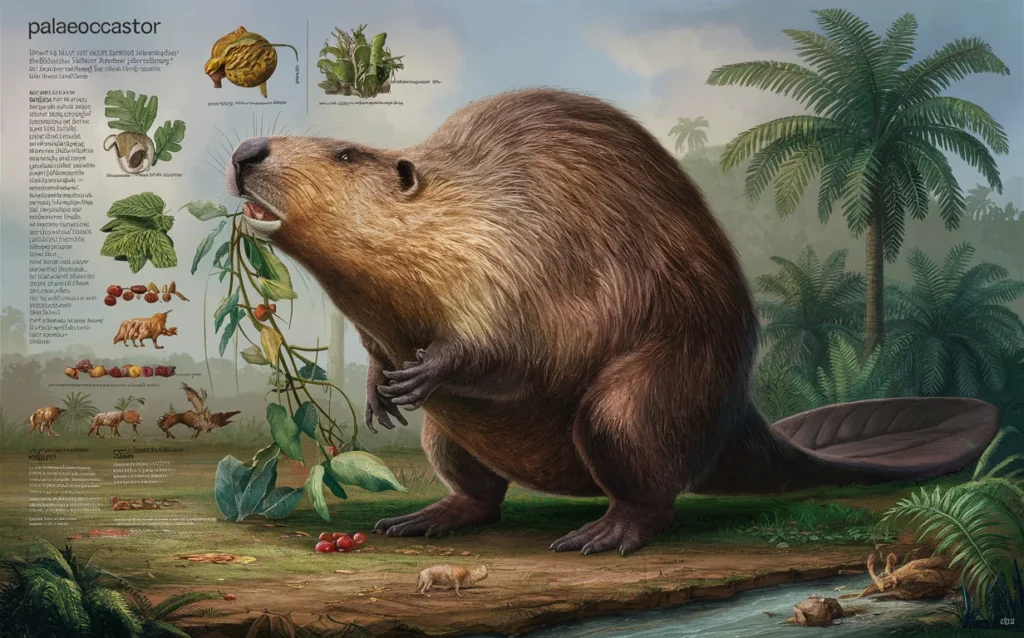Palaeocastor Diet: What Did This Ancient Beaver Eat?
Key Takeaways
- Palaeocastor is an extinct genus of beaver-like rodents from the Miocene epoch.
- It had a diet primarily consisting of plant material, similar to modern beavers.
- Palaeocastor lived in North America and built extensive burrow systems called “Devil’s Corkscrews.”
- Evidence from fossilized teeth and burrows suggests a diet of grasses, woody plants, and possibly roots.
- Its teeth were adapted for chewing tough plant material, indicating a herbivorous lifestyle.

Introduction to Palaeocastor
Palaeocastor, which translates to “ancient beaver,” was a rodent genus that lived around 30 million years ago during the late Oligocene to early Miocene epochs. Fossil evidence of Palaeocastor has been found primarily in North America, where it inhabited what are now the Great Plains. Although it resembles modern beavers, Palaeocastor was distinct in both behavior and diet, adapted to a terrestrial burrowing lifestyle rather than a semi-aquatic one.
Evolutionary Context
Palaeocastor belongs to the Castoridae family, which also includes modern beavers. However, Palaeocastor had a unique niche, characterized by its burrowing behaviors and specific dietary adaptations. It created large, spiral-shaped burrows known as “Devil’s Corkscrews” (Daemonelix), which are fossilized structures still visible today in parts of Nebraska and South Dakota.
Palaeocastor’s Habitat and Lifestyle
Palaeocastor lived in open grasslands and savannas, where it dug extensive burrows to create shelter from predators and the elements. These corkscrew-shaped burrows were likely used as protective habitats, allowing Palaeocastor to thrive in environments that would have otherwise been exposed and hazardous.
Habitat Influence on Diet
Unlike modern beavers, which have a significant association with water and primarily consume the bark and cambium of trees, Palaeocastor likely had a diet that reflected its dry, open habitat. Its burrows were often found in areas rich with grasses and low-lying shrubs, suggesting that it fed on available plant matter near its burrow systems.
Analyzing the Palaeocastor Diet
Based on fossilized teeth and the surrounding fossilized flora, researchers have deduced that Palaeocastor was an herbivore with a diet adapted to the resources available in the grassland and savanna ecosystems of its time.
Table 1: Potential Components of the Palaeocastor Diet
| Plant Type | Examples | Reason for Consumption |
|---|---|---|
| Grasses | Prairie grasses | Abundant and nutritious |
| Woody Plants | Shrubs, small trees | Rich in fiber and minerals |
| Roots & Tubers | Various native species | High in carbohydrates |
| Seeds | Grass seeds | Protein and energy source |
Teeth Structure and Dietary Adaptations
Palaeocastor’s teeth were well-suited to grinding down tough plant materials. The molars had flat surfaces for crushing, much like those of other herbivorous animals that consume fibrous plants. This tooth structure allowed it to process the cellulose-heavy components of grasses and woody plants efficiently.
Adaptations for Herbivorous Feeding
- Enamel Ridges: Palaeocastor had ridges of hard enamel on its molars, which would have been useful for breaking down plant material.
- Continual Growth: Like modern beavers, the teeth of Palaeocastor likely grew continuously, an adaptation seen in animals that chew through hard substances like wood and tough plants.
- Jaw Musculature: The jaw muscles were robust, giving Palaeocastor the ability to chew fibrous plant materials effectively.
Fossil Evidence of the Palaeocastor Diet
Researchers have examined fossilized remnants of Palaeocastor’s teeth and burrow structures, finding clues about its diet and lifestyle. The placement of Palaeocastor fossils in regions with a prevalence of grassland and shrubs suggests it likely consumed what was most readily available in these habitats.
List: Key Fossil Findings on Palaeocastor’s Diet
- Tooth Wear Patterns: Indicate a diet of grasses and woody plants.
- Location of Burrows: Found in areas dominated by savanna-like grassland, rich in shrubs.
- Associated Plant Fossils: Many burrows contain remnants of grass and small woody plant fossils, indicating a diet centered around these plants.
- Pollen Analysis: Fossilized pollen found near burrow entrances suggests Palaeocastor may have consumed various flowering plants.
Comparison with Modern Beavers
Modern beavers (Castor canadensis) have a diet primarily consisting of tree bark, cambium, and aquatic vegetation, which supports their semi-aquatic lifestyle. In contrast, Palaeocastor was adapted to a terrestrial lifestyle and likely consumed more grasses, shrubs, and other dry land vegetation.
Table 2: Palaeocastor vs. Modern Beaver Dietary Comparison
| Trait | Palaeocastor | Modern Beaver |
|---|---|---|
| Primary Diet | Grasses, woody plants | Bark, cambium, aquatic plants |
| Habitat | Grasslands, savannas | Rivers, streams, lakes |
| Burrowing Behavior | Extensive underground burrows | Dams and lodges near water |
| Teeth Adaptation | Flat molars for grinding | Sharp incisors for gnawing |
Ecological Role of Palaeocastor
Palaeocastor likely played a key role in its ecosystem as a primary consumer. By feeding on grasses and shrubs, it would have influenced plant growth and contributed to the shaping of the grassland environment. Its burrows also provided habitats for other species, supporting the local biodiversity of its time.
Influence on the Ecosystem
- Soil Aeration: Palaeocastor’s burrowing behavior aerated the soil, promoting healthy plant growth.
- Predator-Prey Dynamics: Its burrows offered refuge from predators but also became habitats for other small animals.
- Vegetation Control: By feeding on grasses and woody plants, Palaeocastor helped maintain the balance of plant life in its habitat.
Conclusion
Palaeocastor was an ancient rodent that adapted to its grassland environment with a diet consisting of grasses, woody plants, roots, and seeds. Its unique burrowing behavior and dietary preferences set it apart from modern beavers, making it a fascinating subject for paleontologists. Fossil evidence continues to reveal insights into its role in the Miocene ecosystems, shedding light on the complex interplay between prehistoric animals and their environments.
FAQ
1. Was Palaeocastor related to modern beavers?
Yes, Palaeocastor was part of the Castoridae family, which includes modern beavers. However, it was a distinct genus with different adaptations suited to a terrestrial lifestyle.
2. What did Palaeocastor primarily eat?
Palaeocastor primarily ate grasses, woody plants, roots, and seeds. Fossil evidence suggests a diet well-suited to the dry, open grasslands where it lived.
3. How did Palaeocastor create its burrows?
Palaeocastor dug corkscrew-shaped burrows, which likely provided protection from predators and harsh weather. These structures, called “Devil’s Corkscrews,” are still visible as fossilized traces today.
4. Why is Palaeocastor important to paleontology?
Palaeocastor is significant for its unique burrowing structures and insights into prehistoric ecosystems. Its fossils help scientists understand the habitats and climates of the Miocene epoch.
5. How did Palaeocastor differ from modern beavers in diet?
While modern beavers primarily consume tree bark and aquatic plants, Palaeocastor was more adapted to eating grasses, shrubs, and dry-land vegetation.










